Study visit of volunteers to France
A group of 12 volunteers from the ATOM FORUM Foundation made a study visit to French nuclear industry laboratories and institutions from 27-30 August. The scientific trip was made possible thanks to the organisational and financial support of the French Embassy in Poland and the companies: EDF and Areva.
The first stop on the scientific trip was the AREVA plant in St-Marcel. This plant, which has been in operation since 1975, manufactures heavy primary circuit components such as the reactor vessel, steam generator and pressure stabiliser. These components have been installed in all of France’s 900 MW and 1450 MW nuclear power plants.

The visit began with a presentation given by Mr Yves Lucas, who outlined not only the history of the St-Marcel plant, but also AREVA’s activities and objectives. Its components are installed in more than a hundred nuclear reactors in eleven countries around the world from the USA (22 reactors) and Brazil (1 reactor), through European countries such as the UK (1 reactor), Sweden (2 reactors), Belgium (5 reactors), Switzerland (2 reactors) to the Repu-blica of South Africa (2 reactors), China (6 reactors) and South Korea (2 reactors). Servicing and component replacement is carried out on an ongoing basis to improve safety and energy efficiency. The main customer is EDF, and in France alone AREVA components are found in 58 power stations. The EPR (European Pressurised Reactor) currently under construction at Flamanville belongs to Generation III . Power stations based on this reactor type are also being built in China (Taishan) and Finland (Olkiluoto), and AREVA manufactures and supplies components for these plants.
The precision and meticulous workmanship of the components was evident during a tour of the three-shift production facility, where the size of the individual components was impressive. The delivery of the individual components themselves to the customer is mainly carried out by water – first by river, then by sea. The manufacture of the final product is a process that lasts for dozens of months. The scale of the project and the need to meet safety, as well as quality requirements, dictates that the manufacturer carries out rigorous research and testing. Great emphasis is placed on proper training of workers and continuous improvement of the production process. One example is welders, who undergo three years of training before they are allowed to work properly. In addition, on a two-year cycle, they must pass examinations in order to obtain the appropriate certificate to prove their qualifications.
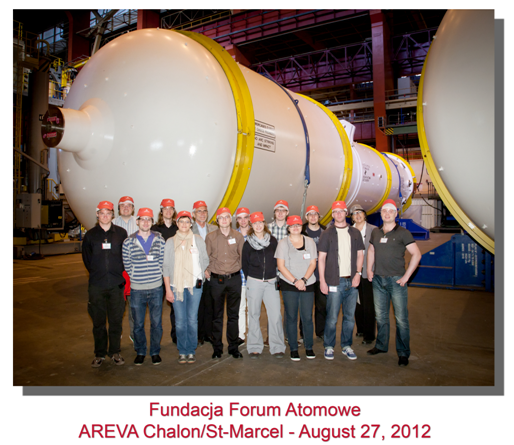
The visit to the St-Marcel plant gave the volunteers the opportunity to see in full the various heavy components installed in nuclear power plants and to learn about the procedures as well as the requirements of this type of plant. It was interesting to see the structural elements of the first reactor circuit that will be installed in the nuclear power plant under construction at Flamanville, based on an EPR-type reactor.
The following day, 28 August, the Foundation’s volunteers went to the public information centre of the Cruas nuclear power plant (EDF). The plant has 4 units with PWR-type reactors of 956 MW each. There is a well-organised, interactive exhibition. It shows all aspects of the energy structure in France, with a particular focus on nuclear power. The exhibition is also aimed at younger visitors. There are competitions and quizzes for them with prizes handed out at the end of the entire tour. Among other things, visitors could see well-made models of a fuel cassette, a nuclear power plant and a reactor vessel with steam generators. In addition to this, several short films on the publicly accessible EDF website were shown. Very impressive is the large painting on one of the cooling towers, and the process of its creation was shown on film. The author of this work is the French artist Jean-Marie Pierret. 4,000 litres of paint and 8,000 hours of work were used to create this 135-metre-high fresco, which symbolises the important elements of the region: water and air.
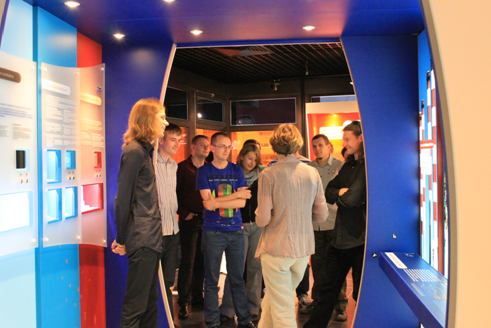
Next on the agenda was the Tricastin power plant (EDF), which has 4 PWR units of which 3 are 915 MW and 1 is 940 MW. A presentation by one of the power plant staff provided key information about the Tricastin power plant with a focus on the control and measurement system. The control stations are located within a 10 kilometre radius and measure samples of air, soil, milk and groundwater, among others. The total number of measurements taken by EDF and the ASN (French Nuclear Regulatory Authority) is around 20000 per year. Considerable attention has been paid to the cooling circuit. Cooling is carried out in an open circuit using water drawn from a canal fed by the Rhône River. This was followed by a demonstration of the operation of the power station from the inside, where an extremely meticulous control system is in place for both safety and dosimetry. Workers at the power station are required to wear a dress code consisting of special overalls and individual protective equipment. In this building is the pool fuel storage area, where the guide talked in great detail about the handling of spent fuel in the power station. On leaving this sector of the power station, everyone was required to undergo a dosimetry check, which showed no absorbed effective dose of radiation. The next place was the control room, where it was possible to get acquainted with the work of the operators, followed by the engine room. In a hall 400 metres long and 40 metres wide, there were four turbine sets. Each is painted a different colour for recognition purposes. Nearby are the water treatment plants, laboratory buildings and other important facilities needed for the power plant. Visiting the site was an extremely valuable experience showing how extremely high the safety culture relating to the facility and, above all, to the workers is.
On Wednesday, 29 August, the volunteers arrived at the CEA (Commissariat à l’Energie Atomique et aux Energies Alternatives) site in Marcoule. This is a scientific and research institution, working with, among others, the National Centre for Nuclear Research in Spruce. It was founded in 1945 in Paris, dealing only with nuclear energy, and in 2010 broadened its scope to include alternative energies. About 5 000 people work at Marcoule and the entire complex covers an area of more than 315 ha. A number of companies have placed their investments in the centre. In addition to the CEA, corporations linked to the nuclear industry such as AREVA NC, AREVA MELOX, TNI, Socodei and even Cisbio, which is a supplier of nuclear medicine products, are present. They receive around 20,000 visits a year, during which they introduce visitors to the centre’s activities. The research covers four thematic areas, which include energy, protection and safety, information and technology for the medical industry, as well as many other fields such as physics, radiobiology, electronics. They are also focusing on the study of the fuel cycle and the vitrification process of radioactive waste, trying to discover the optimal use of as much waste as possible and to minimise its negative impact on the environment. They are currently working on a prototype Generation IV reactor, which is expected to be built by the end of 2020. This project aims to achieve full fuel cycle closure by burning actinides and light decay products. At this point, 96% of nuclear materials are recycled. This practice saves up to 30% of the total resources required for the open fuel cycle. Approximately 30,000 soil, water, fruit and air cleanliness measurements are taken per year.
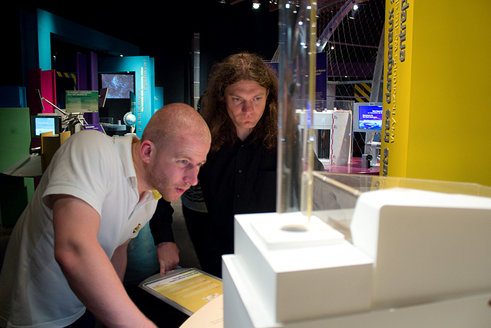
In 2006, the Visiatome, a community information centre, was created in the form of an interactive permanent exhibition that presents every aspect of nuclear energy (from the phenomenon of radioactivity, the principle of the power plant, the use of energy to the reprocessing and disposal of radioactive waste). This centre provides a lot of training in energy generation both from the atom and other low-carbon alternative methods. The next item on the agenda was a tour of the Atalante laboratory and chemistry laboratory, where research into the activity and properties of radioactive waste is carried out. These are performed using a number of methods, such as extraction, mass spectroscopy, laser spectroscopy, magnetic resonance and calorimetric methods. In the laboratory for the vitrification of radioactive waste (Creuset Froid), the separation of plutonium and uranium is carried out, which is later used in MOX fuel (production takes place at the MELOX industrial plant). Waste solidification methods were also presented. Initially solidified in glass, a method of solidification in ceramic glass (which binds the waste for longer) and a mixed glass-metal method were developed. Each sample is tested several times, starting with the simplest indicators such as temperature, pressure and water and moving on to more complex methods. The theoretical and scientific side of the centre’s activities is handled by laboratories divided into six departments, including chemical, physical, observational and theoretical.
On the last day of the visit, the Foundation volunteers visited the underground ANDRA (Agence nationale pour la gestion des déchets radioactifs) laboratory located in the Meuse area. The presentation preceding the descent into the underground laboratory provided comprehensive information on the reasons for the establishment of the research facility, its current objectives, as well as its plans for the coming years. Its location, it was explained, was due to the lack of seismic activity, low water circulation, a suitable rock system, the possibility of locating waste at the right depth, and the lack of valuable extractable raw materials in the area. The current main task facing the laboratory staff is to develop the best technology and equipment to be used in the construction and operation of a high-level and long-lived radioactive waste repository in Bercy.
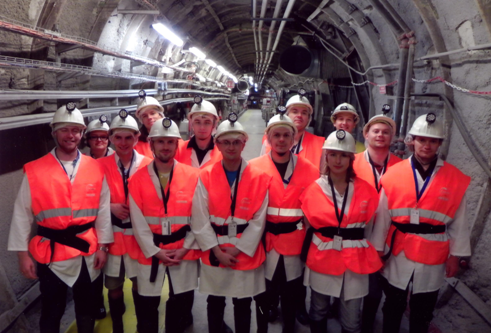
Located half a kilometre underground, the constantly expanding research centre can be reached via one of two shafts. In the galleries and tunnels to which they lead, research is conducted into the deformation of rocks, their permeability, diffusion or retention properties. The experiments carried out are not only limited to geology, but are also related to the effects of radioactive waste on rocks and vice versa. Researchers are not only looking for optimum tunnelling methods or the most suitable materials, but are also testing prototype machines that will be used during the construction and operation of the repository.
It should be noted that the research centre also conducts educational campaigns to promote awareness of developments in research into ionising radiation, nuclear power, radioactive waste and its disposal. Among other things, the exhibition halls show the scientific and engineering experiments carried out on how to transport waste underground, as well as the construction and composition of the waste containers.
The Foundation volunteers were delighted with the hospitality and enthusiasm with which they were received at all the sites visited, for which they would like to thank the people who helped organise this trip and those who showed them around the facilities visited.
On their way back home, the Volunteers paid tribute to the Polish Scientist Maria Skłodowska-Curie and laid flowers on her grave in the Paris Pantheon.
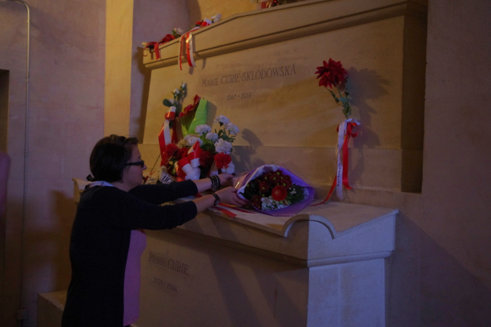
There is no doubt that the study visit to France helped the ATOM FORUM volunteers to deepen their knowledge on the use of nuclear energy, as well as to understand its impact on the environment and human health and its role in the development of the energy industry. It was a good lesson about the benefits and drawbacks, as well as the safety and costs that are associated with nuclear energy production. The knowledge gained during the trip will be used in the scientific work of the participants, as well as confirming the Foundation’s capacity to engage more effectively in the national public campaign on nuclear energy. We know that nuclear energy still arouses anxiety and uncertainty in society, which is related to the lack of knowledge and false stereotypes often publicised by the media. Therefore, the volunteers of the FORUM ATOMOWE Foundation are confident that their work, ideas and projects will help to change this situation, the consequence of which will undoubtedly be public acceptance and a “green light” for nuclear energy in Poland.
We would like to thank Ms Hania Kurzydym from EDF Polska, Mr Dominik Le Masne and Ms Klara Tucholka from the French Embassy in Poland, and Mr Adam Rozwadowski from Areva Polska, thanks to whom our trip to France could be made possible. Thank you for your time and financial support.
The ATOM FORUM Foundation team